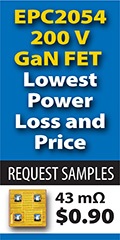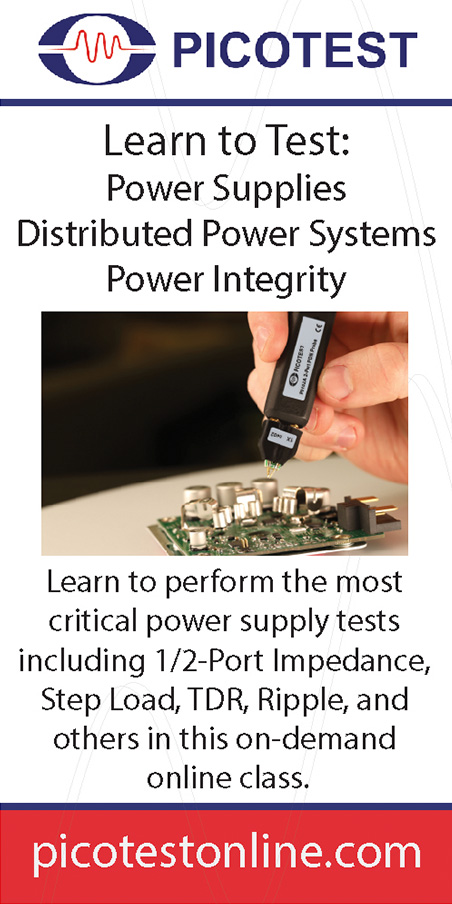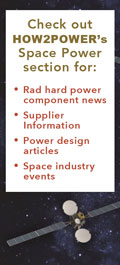 |
|
IN THIS ISSUE:
» A Guide To Power Electronics Design For Off-Battery Automotive (Part 4): DC-DC Conversion From 400 V
» Designing An Open-Source Power Inverter (Part 8): Converter Control Power Supply
» Why Phase-Shift Converters Are More Accurate Than PWM Converters
» Focus On Magnetics:
Popular Magnetic Cores And Wires: Their Properties, Accessories And Tables
» New Power Products
» Other Top Power News
From the Editor's Desk David G. Morrison
Editor, HOW2POWER TODAY

As another year begins to wind down, we have the usual holidays to look forward to, but also a reason for celebration in our professional lives—the 75th anniversary of the invention of the transistor at Bell Labs. This milestone will be celebrated next month—either on December 16, which is cited as the day in 1947 when the point-contact bipolar transistor achieved its first notable results or on December 23, which marks the day a formal demo was made within Bell Labs. In anticipation of the anniversary, the IEEE and other organizations have issued announcements, including one by the Electron Devices Society proclaiming a year-long celebration in 2022 and 2023 to mark what was essentially the birth of solid-state electronics. We can expect that much of the news coverage and commentary surrounding this anniversary will focus on the evolution and impact of the transistor through VLSI, and how that single transistor in 1947 led us down the path to billions of CMOS transistors on a chip. It’s likely that relatively little will be said about the role of the transistor in power electronics, and how it has spearheaded tremendous advancement and growth with the commercial introduction of power MOSFETs in the 70s, IGBTs in the 80s, and SiC MOSFETs and GaN HEMTs in the 2010s. In power electronics, the power transistor is king, so the evolution of its multiple technologies continues to propel the development of the field across countless applications. We regularly witness the impact of power transistor developments in the technical articles and product news stories published in this newsletter. The latest power semiconductor introductions remind us that the transistor continues to be refined and reimagined for the advancement of power supply performance. With wide-bandgap transistors still in their early stages of development, we can hardly imagine what another 75 years will bring.
|
|

|
HOW2POWER EXCLUSIVE DESIGN ARTICLES 
|
A Guide To Power Electronics Design For Off-Battery Automotive (Part 4): DC-DC Conversion From 400 V
by Timothy Hegarty, Texas Instruments, Phoenix, Ariz.
At the heart of every battery electric vehicle (BEV) and plug-in hybrid electric vehicle (PHEV) are several power electronics subsystems: a traction inverter, onboard charger, dc-dc converter and battery management system. Two voltage domains exist, based on a high-voltage battery pack for traction and a low-voltage auxiliary battery to supply legacy vehicle loads such as body electronics, lighting and infotainment. Whereas an ICE vehicle uses a belt-driven alternator to charge the low-voltage battery, a BEV or PHEV uses an auxiliary power module (APM) for dc-dc conversion between the high-voltage battery pack and the low-voltage battery. This traction-to-auxiliary (T2A) dc-dc converter operates continuously during vehicle use and behaves effectively as an “electric alternator,” with power levels up to 5 kW. This article charts several steps within the context of designing a dc-dc power stage with a high conversion ratio for an APM subsystem.
Read the article…
|

The APM provides dc-dc conversion
between the high-voltage battery
pack and the low-voltage battery
and in some cases requires
bidirectional power flow. |

|

The 24-V to 12-V switching supply
has a common-passive (CP or buck)
power-transfer circuit employing
hysteretic control. |
Designing An Open-Source Power Inverter (Part 8): Converter Control Power Supply
by Dennis Feucht, Innovatia Laboratories, Cayo, Belize
Having delved into the design of the inverter stage circuitry and its magnetics in recent installments in this series, this article now turns its attention to another stage of the Volksinverter—the converter control power supply. As a converter controller, the BCV401 has its own 24-V-input switching supply that outputs +12 V to control circuits. The control power supply is a minimal-parts switching converter using generic components. The operation of this switching power supply will be described in the first section of this article and a prototype will be presented. This converter uses hysteretic control, primarily in continuous conduction mode except at very light loading. In the second half of this article, hysteretic control will be explained and design equations will be given as well as measured waveforms confirming the expected operation of the converter.
Read the article…
|

Why Phase-Shift Converters Are More Accurate Than PWM Converters
by Gregory Mirsky, Design Engineer, Deer Park, Ill.
PWM and phase-shift power converters are being widely used for medium- and high-power applications. The dc output of these converters is obtained from a filtered rectangular pulse train. Ideally, the converter feedback control system that regulates the output voltage derives the average value of the pulse train and keeps it proportional to the internal or external reference voltage. Typically the converter output should follow the reference voltage very accurately over a wide range of the duty-cycle to achieve high stability over a wide voltage range, requiring strict proportionality of the output voltage to the duty-cycle. However, this tight relationship between duty cycle and output voltage is not maintained if —in addition to the pulse train—there is some extra voltage filling the gap between pulses. Such is the case with PWM converters.
Read the article…
|

In PWM converters, resonating
voltage on the secondary side fills
the gaps between the rectangular
pulses thus trying to add up to
the output average voltage, but
reducing the duty-cycle. |


FOCUS ON MAGNETICS 
Sponsored by Payton Planar Magnetics
A monthly column presenting information on power magnetics design, products, or related technology |

Popular Magnetic Cores And Wires: Their Properties, Accessories And Tables
by Dennis Feucht, Innovatia Laboratories, Cayo, Belize
Magnetic components such as inductors and transformers are usually designed for a specific application. However, certain applications of these components are sufficiently popular that they are offered as standard products. More commonly, though, magnetic components are custom-designed, resulting in thousands of magnetic parts variations designed from more basic components: cores and conductors (wire). Although core and wire components also have multiple variations, the number of them is manageable for stocking the inventory of a power-electronics laboratory or prototyping facility. This article describes how the Innovatia laboratory is stocked as an example of how relatively few cores and wire sizes can suffice for a wide range of typical magnetics designs. What not to stock (much of) is also recommended.
Read the full article…
|

 |
 |

 |

|

 |

|

 |
|

The future of standardized defense platforms using MOSA, SOSA and VPX open architectures
Recent trends in the defense industry show there is a convergence towards standardizing electronic systems using open standards. This technical paper provides a better understanding of the benefits and advantages of moving to an open architecture modular power supply system approach and how this modular design supports greater flexibility, scalability, reliability, and faster time to market as compared to non-standardized power design options.
Find out more.
|
More from Vicor:
• Aerospace and defense power FAQs
• New SOSA aligned configurable power systems
|
|
|

 — POWER PRODUCTS IN 3 IMAGES OR LESS — POWER PRODUCTS IN 3 IMAGES OR LESS 
|


Efficient Power Conversion’s
EPC2619 GaN FET. |
Next-Generation GaN Technology Doubles Power Density
 Photo: The first of EPC’s Gen 6 devices, the 80-V, 4-mΩ GaN FET in a 1.5-mm x 2.5-mm footprint offers higher performance than the company’s Gen 5 devices and further widens the performance advantage of the company’s GaN FETs versus traditional silicon MOSFETs. The device targets high power density applications including dc-dc converters and motor drives. Photo: The first of EPC’s Gen 6 devices, the 80-V, 4-mΩ GaN FET in a 1.5-mm x 2.5-mm footprint offers higher performance than the company’s Gen 5 devices and further widens the performance advantage of the company’s GaN FETs versus traditional silicon MOSFETs. The device targets high power density applications including dc-dc converters and motor drives.
See the full story…
|

Power Integrations’ PI
Magnetics-Designer. |
Vendor’s Tool Automates Planar Magnetics Design For Power Supply Designs Using Its Offline Switcher ICs
 Screenshot: The planar magnetics builder in PI Expert automatically generates a planar transformer design with full electrical specification and build documentation in just five minutes. Users enter electrical circuit parameters and the tool generates all aspects of the transformer design, except for the choice of the core. Screenshot: The planar magnetics builder in PI Expert automatically generates a planar transformer design with full electrical specification and build documentation in just five minutes. Users enter electrical circuit parameters and the tool generates all aspects of the transformer design, except for the choice of the core.
 Screenshot: PI Expert also estimates transformer performance and incorporates this data into power supply performance. Screenshot: PI Expert also estimates transformer performance and incorporates this data into power supply performance.
See the full story…
|



Tell-i Technologies'
VON1k5Vm sensor. |
1-kV Voltage Sensor Measures VDS Of SiC And GaN Transistors
 Waveforms: The contactless sensor measures the voltage across high-voltage power transistors with high resolution during the transistors’ on-state, enabling health monitoring and prognostics of high-frequency power converters using GaN and SiC power switches. Waveforms: The contactless sensor measures the voltage across high-voltage power transistors with high resolution during the transistors’ on-state, enabling health monitoring and prognostics of high-frequency power converters using GaN and SiC power switches.
See the full story…
|

Infineon Technologies’
CoolMOS PFD7 MOSFET
family. |
950-V Superjunction MOSFETs With Fast Body Diode Address Lighting And Industrial SMPSs
 Photo: The superjunction MOSFETs feature reduced on-resistance and 60% improved gate charge compared to earlier-generation CoolMOS C3 900-V devices. Photo: The superjunction MOSFETs feature reduced on-resistance and 60% improved gate charge compared to earlier-generation CoolMOS C3 900-V devices.
See the full story…
|



Taiwan Semiconductor’s
TQL8xx low-dropout
regulators. |
Another Source For Automotive LDOs With Options For Higher Integration
 Table: This family of AEC-Q101 qualified, low-dropout regulators offers manufacturers a reliable alternative source for the critically important linear regulators used in numerous battery-driven automotive functions, including dashboard, cluster, climate control, fuel pump and advanced driver-assistance systems. Table: This family of AEC-Q101 qualified, low-dropout regulators offers manufacturers a reliable alternative source for the critically important linear regulators used in numerous battery-driven automotive functions, including dashboard, cluster, climate control, fuel pump and advanced driver-assistance systems.
See the full story…
|
|










|

 |
|  |

 |
|  |

 |
|  |


 Infineon Technologies and VinFast, Vietnam’s first global smart electric car maker, will set up a joint application competence center focusing on electromobility. Infineon Technologies and VinFast, Vietnam’s first global smart electric car maker, will set up a joint application competence center focusing on electromobility.
 The 2023 IEEE Transportation Electrification Conference (ITEC), which will be held in Detroit on June 20-23, has issued a call for short course and tutorial proposals. The 2023 IEEE Transportation Electrification Conference (ITEC), which will be held in Detroit on June 20-23, has issued a call for short course and tutorial proposals.
 Exhibit and supporter registration is now open for NSREC 2023, which will be held July 24-28 in Kansas City, Missouri. Exhibit and supporter registration is now open for NSREC 2023, which will be held July 24-28 in Kansas City, Missouri.



 The 35th International Symposium on Power Semiconductor Devices and ICs (ISPSD 2023), which will take place May 28-June 1 in Hong Kong, has issued its second call for papers. The 35th International Symposium on Power Semiconductor Devices and ICs (ISPSD 2023), which will take place May 28-June 1 in Hong Kong, has issued its second call for papers.
 Bloom Energy has chosen CoolSiC MOSFETs and CoolSiC diodes from Infineon Technologies to process electrical power in Bloom’s Energy Server, the company’s fuel cell offering. Bloom Energy has chosen CoolSiC MOSFETs and CoolSiC diodes from Infineon Technologies to process electrical power in Bloom’s Energy Server, the company’s fuel cell offering.
 Professor Ćuk will offer his interactive online Power Electronics Masterclass, April 3-May 28, 2023. Professor Ćuk will offer his interactive online Power Electronics Masterclass, April 3-May 28, 2023.

ABOUT THIS NEWSLETTER: Thank you for reading HOW2POWER TODAY.
How2Power sends no more than one e-mail per month to registered users. Continuing your subscription ensures you'll receive future newsletters. Manage Your Subscription
©2020 All rights reserved. www.how2power.com
|
|